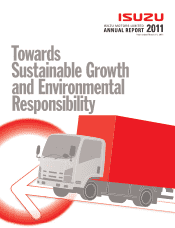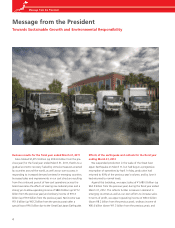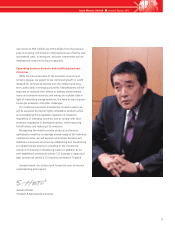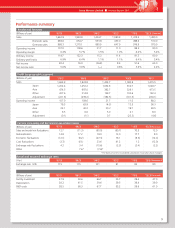Isuzu 2011 Annual Report Download - page 8
Download and view the complete annual report
Please find page 8 of the 2011 Isuzu annual report below. You can navigate through the pages in the report by either clicking on the pages listed below, or by using the keyword search tool below to find specific information within the annual report.
6
Special Feature
Special Feature: Highlights from Isuzu Motors
Financial Statements A&A Company Report
Business outlook for the fi scal year ending March 31, 2012
Isuzu announces earnings estimates based on a recovery in production in the wake of the
Great East Japan Earthquake and future demand trends
Despite the lingering effect of the Great East Japan Earthquake during the fi rst half, Isuzu expects
sales to increase during the fi scal year ending March 31, 2012, due to factors including further growth
in demand in emerging countries and increased sales of industrial engines. In terms of profi t, the
Company expects soaring material costs, the strong yen, and development costs and other up-front
investments in advance of future expansion to offset increased sales, pushing operating income down
to ¥80.0 billion (a decrease of ¥8.2 billion from the previous year). As the Company moves beyond
earthquake-related extraordinary losses, net income is expected to rebound to ¥65.0 billion (an
increase of ¥13.4 billion from the previous year).
Highlights
➊ Assuring an advantageous position in emerging and resource-producing countries that
are expected to grow in the future
Notably, overseas sales account for about 60% of Isuzu’s consolidated sales, and the Company
has established an advantageous position in emerging countries in Asia and beyond, highlighting the
success of its long-running efforts to strengthen overseas performance. With operations in not only
Asia, but also in the Middle East, Africa, South and Central America, Oceania, and Europe, Isuzu’s
business portfolio is characterized by global distribution.
In light of continuing robust demand for trucks, particularly in emerging countries, Isuzu plans to
ship 625,000 commercial and light commercial vehicles during the fi scal year ending March 31, 2012,
of which 576,000 are destined for overseas markets. This exceeds performance milestones set prior to
the fi nancial crisis. Under these plans, overseas exports of commercial vehicles will set a new high.
➋ Achieving high profi tability despite the strong yen through the aggressive pursuit of
product competitiveness and low-cost operations
Profi ts by geographic segment indicate that the Japan, Asia, and Other segments are generating
profi ts commensurate with their respective sales fi gures.
Particularly noteworthy is the fact that Isuzu’s manufacture and sale of commercial vehicles, which
are manufactured in Japan and shipped worldwide, are independently profi table despite the strong
yen. The Company’s domestic businesses are generating stable profi ts despite the slowdown in new-
vehicle demand thanks to the streamlining of domestic sales structures and the expansion of life
cycle businesses such as service and parts. Most overseas exports are priced in yen, and transactions
denominated in foreign currencies account for just 10% of overall sales. While the exchange rate
poses certain challenges, the Company has managed to grow sales as the market recovers by
overcoming the strong yen with highly competitive products. Efforts to implement low-cost operations
in the wake of the Lehman Shock have taken root, and improvements in the Company’s profi t structure
have allowed it to achieve stable profi ts despite the yen’s strength.
➌ ASEAN light commercial vehicle business
In the pick-up truck segment, which accounts for approximately half of all automobile sales in
Thailand, Isuzu continues to enjoy robust sales as the top brand. The Company has steadily increased
exports of pick-up trucks from Thailand since the transfer of production there from Japan in 2004,
and the ASEAN light commercial vehicle business continues to grow steadily. In March 2010, Isuzu
transferred pick-up truck development to Thailand, including decision-making authority, and created
a business structure capable of accomplishing the entire development process locally.
➍ Industrial diesel engines: A new mainstay of Isuzu’s business
Diesel engines from truck manufacturers, who are leading the way in complying with environmen-
tal regulations, are being widely adopted for use in industrial machinery such as products made by
construction machinery manufacturers. Signifi cant growth in shipments of Isuzu’s industrial diesel
engines refl ects factors such as increasing demand for construction machinery in emerging countries,
strengthening of emissions regulations worldwide, and the Company’s extensive product portfolio.
It is noteworthy that the growth in shipments is not limited to Japanese manufacturers, but
extends to construction machinery manufacturers in China.
Share data
Principal market: First Section, Tokyo Stock Exchange
Share price (as of 8/31/2011): ¥341
Outstanding shares: 16.97 million
Percentage of foreign ownership: 28.61%
Share price
Isuzu—Towards Sustainable Growth
Business Performance (consolidated)
Fiscal year Sales Operating income Ordinary income Net income EPS Dividend
(millions of yen) Year-on-year (%) (millions of yen) Year-on-year (%) (millions of yen) Year-on-year (%) (millions of yen) Year-on-year (%) (yen) (yen)
’07/3 1,662,925 5.1 106,890 18.0 114,697 22.2 92,394 56.7 51.54 4.0
’08/3 1,924,833 15.7 109,573 2.4 122,322 6.6 76,021 -17.7 44.36 5.0
’09/3 1,424,708 -26.0 21,651 -80.2 15,236 -87.5 -26,858 -15.85 3.0
’10/3 1,080,928 -24.1 11,010 -49.1 11,393 -25.2 8,401 4.96 3.0
’11/3 1,415,544 31.0 88,220 701.3 91,258 701.0 51,599 514.2 30.45 4.0
’12/3 (Forecast) 1,480,000 4.6 80,000 -9.3 80,000 -12.3 65,000 26.0 38.36 5.0
Discussion: Explanatory materials from Isuzu’s briefi ng on earnings estimates (consolidated) for the fi scal year ending March 31, 2012





















